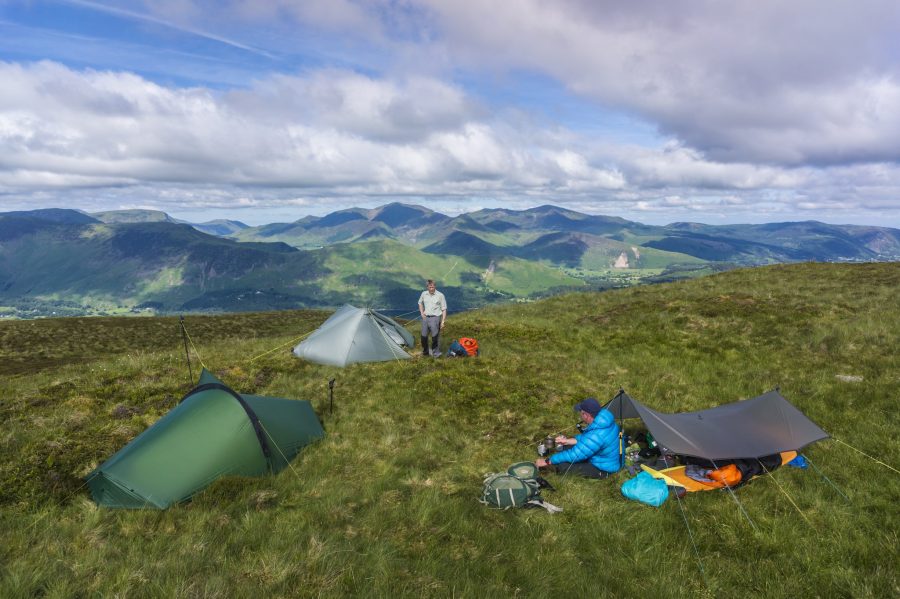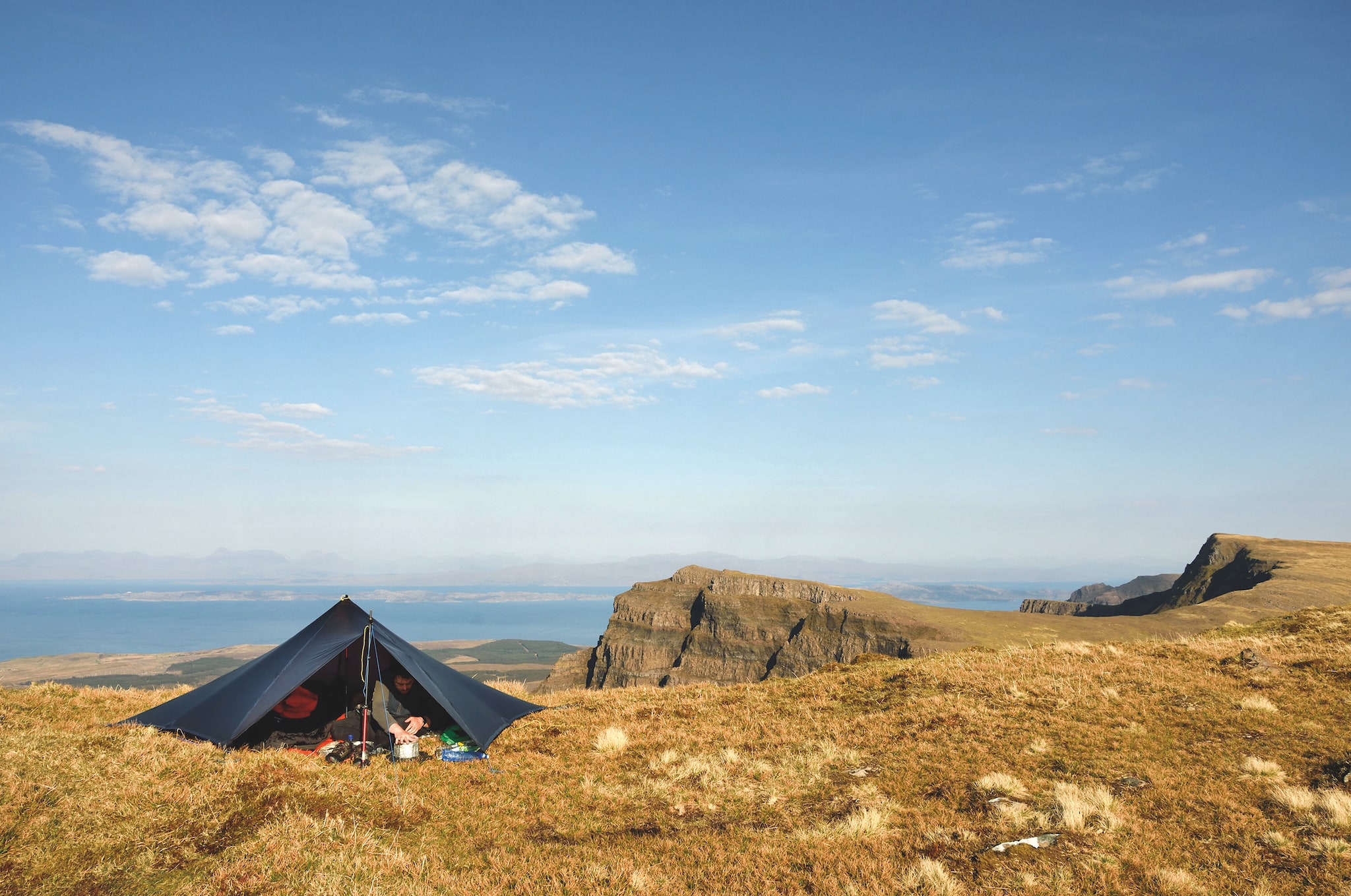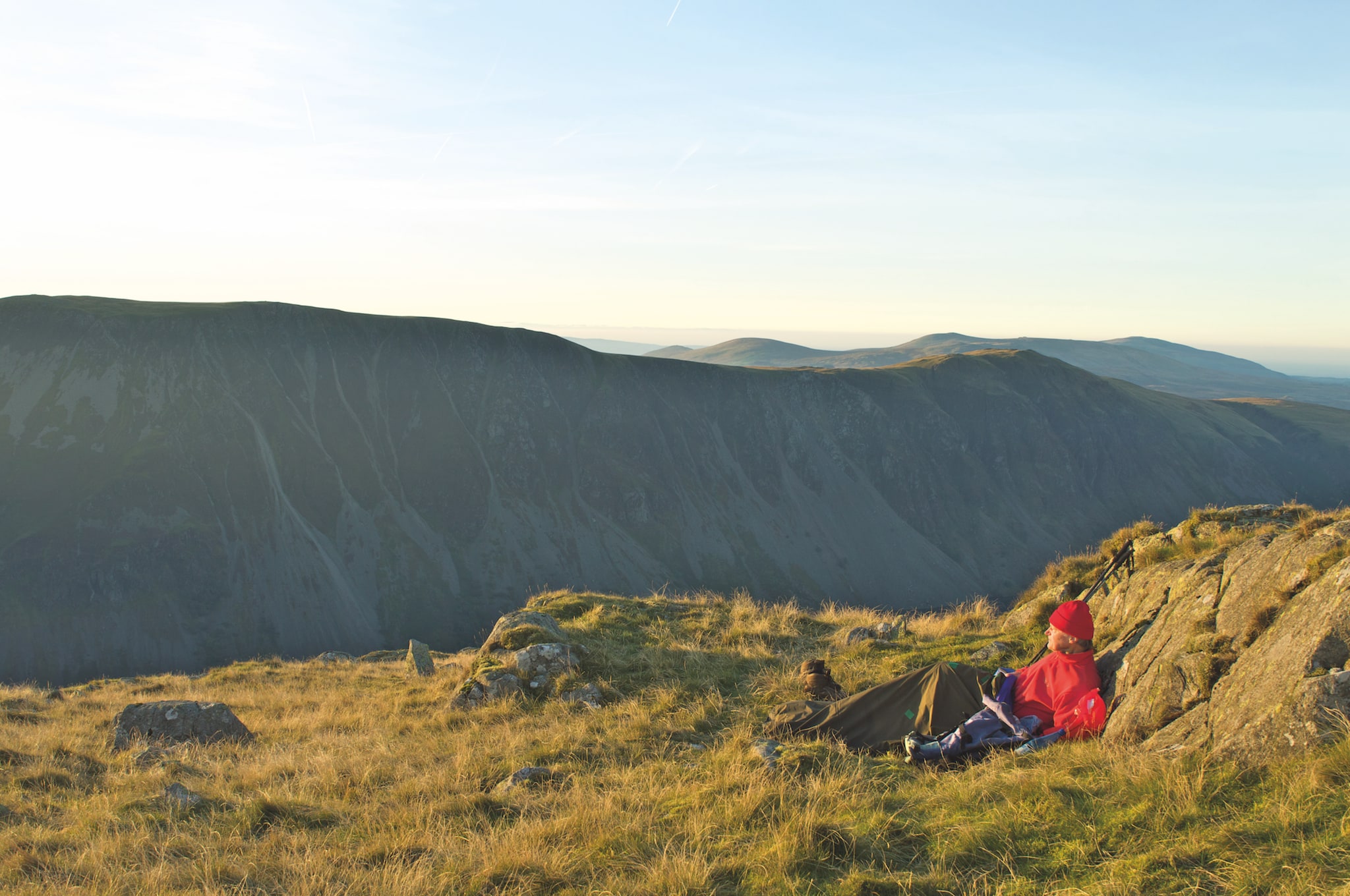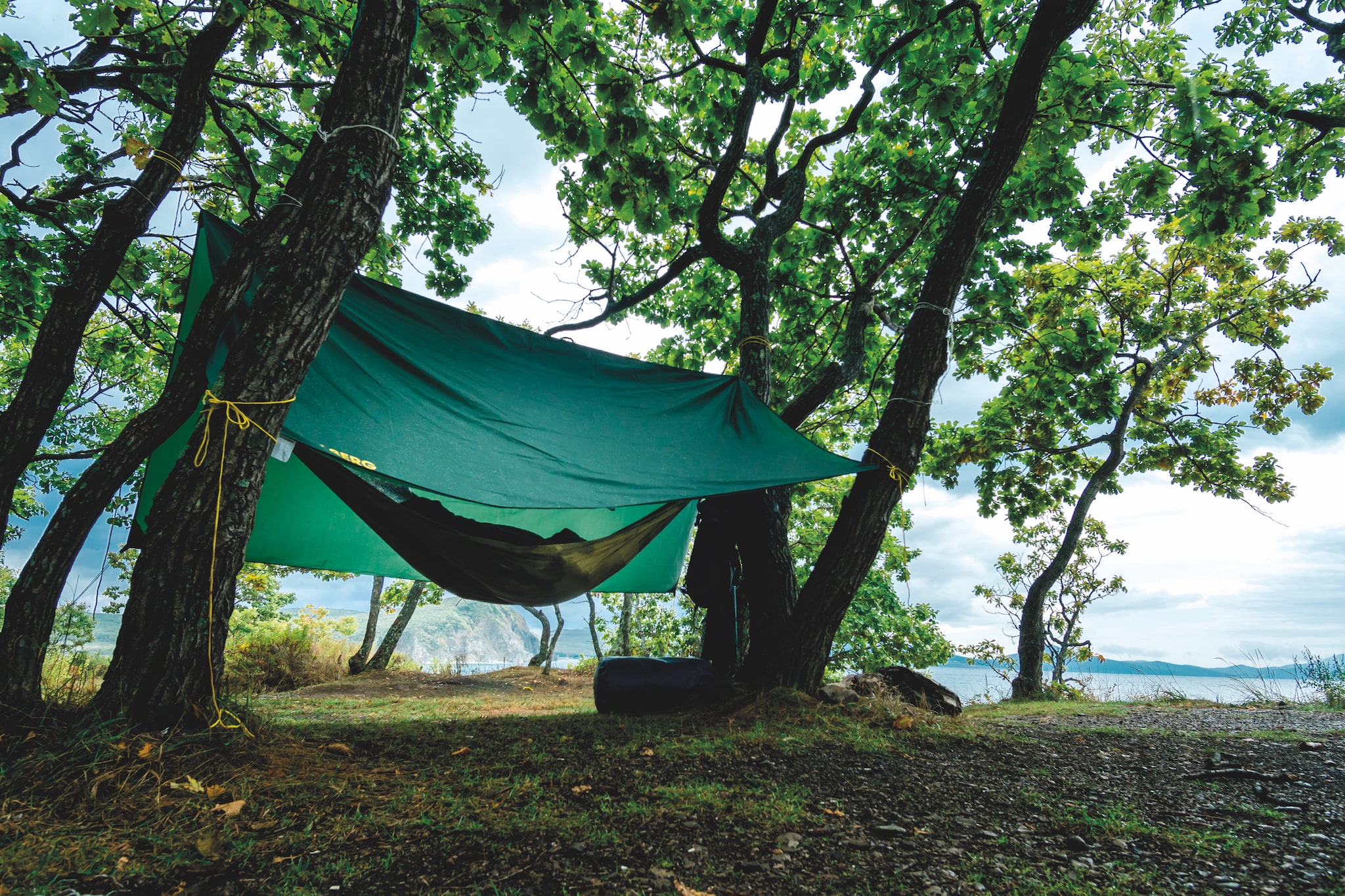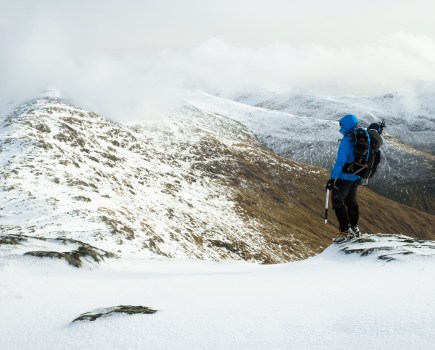Chris Townsend, Alex Roddie and Ronald Turnbull share their tips on how to be comfortable even while keeping weight down.
I know what you’re thinking – the words ‘comfortable’ and ‘camping’ can be poor bedfellows unless you’ve packed the car with the big family tent and air mattress. But the truth is that you can be comfortable even while wild camping.
This skills guide was first published in the May 2018 issue of The Great Outdoors.
Planning a sleep system
Putting together the right combination of sleeping equipment will always be time well spent, says Gear Editor Chris Townsend.
Rather than just thinking of a sleeping bag it’s best to think of a sleep system – insulating mat, sleeping bag or quilt, liner or sleep clothes, and pillow. All of these can affect how well you sleep.
Mat
Starting at the bottom, the purpose of an insulating mat is to protect you from ground cold – your sleeping bag will flatten where you lie on it – and provide some softness. If you prefer a soft mattress at home look for a soft thick mat for camping. A thin harder one may not be comfortable enough. Down and synthetic insulation-filled mats are good for both comfort and warmth. They are heavier and bulkier than thinner mats though. If you use an inflatable mat pack a repair kit. A punctured mat is cold and uncomfortable – I speak from experience!
Sleeping bag and liner
With sleeping bags, warmth is the most important factor. Temperature ratings (see below) are only a rough guide to this. Whether you sleep warm or cold matters too. In particular, cold sleepers may need bags rated 5 or even 10°C lower than expected temperatures.
The fit of a bag is also important. If you feel restricted you won’t sleep well. Some people find all bags a bit confining. Quilts are the answer to this as they can be spread out to allow complete freedom of movement.
On trips with widely varying temperatures, two sleeping bags with one inside the other or a sleeping bag and a quilt are more versatile than a single sleeping bag. Sleeping bag liners made from silk, cotton or wicking synthetic add warmth to a bag and help keep it clean. But I prefer a clean set of base layers and socks, as I can remove or add items if I start to feel too hot or cold.
Pillow
A pillow is the final piece of a good sleep system. I’ve always found clothing in a stuffsack adequate but I only use one thin pillow at home. For those who want a thicker, softer pillow there are light synthetic, down- filled and inflatable ones available. But a down jacket in a stuffsack works too, and you can always put the jacket on if you get cold.
Sleeping bag temperature ratings
Most manufacturers use the European EN 13537 rating for sleeping bags. The ratings are calculated using a mannequin with 15 heating zones and temperature zones. The mannequin is dressed in thermal long-sleeved top and leggings plus long socks and placed in the sleeping bag on a mattress.
The standard gives four ratings:
- Upper comfort limit: the highest temperature at which a “standard man” weighing 70kg should feel comfortable.
- Comfort:: the lower limit at which a “standard woman” weighing 60kg in a relaxed posture such as lying on the back should be comfortable.
- Lower comfort limit: the lower limit at which a “standard man” weighing 70kg in a rolled-up body position should be comfortable.
- Extreme temperature:temperature where a standard woman will feel very cold and there is a risk of frostbite or hypothermia.
Gear Editor Chris Townsend says: “You should only use the rating provided as a guide, because it doesn’t mean you will be warm at the lowest temperature.
“The key ratings are the Comfort and Lower Comfort ones as these give an idea of the lowest range of temperatures for comfort in a bag. Most people are likely to feel too cold for comfort long before the extreme temperature is reached. I’d take the last as meaning that the bag is unsuitable for this temperature.
“Indeed, I think the Extreme rating is potentially so misleading that it should be scrapped.”
What to wear to sleep
Alex Roddie recommends…
- Long johns and a lightweight top are ideal. Synthetic, silk or merino are all fine, although silk can feel better against the skin.
- On long trips, look for clothing with Polygiene odour control.
- It’s a good idea to keep a dedicated pair of warm socks to wear inside your sleeping bag.
- In very cold conditions you may want to add a balaclava, especially if you’re using a quilt that doesn’t wrap around your head. Very light down-filled balaclavas are now available.
- Insulated clothing such as a down or synthetic jacket can really boost the performance of your overall sleep system although it’s important to make sure your sleeping bag is roomy enough to avoid squashing the insulation in any additional layers you put on during the night.
Wild camping
Chris Townsend’s top tips for a comfortable pitch.
- Plan on stopping early enough that you have time to search for a site and to move on a little way if necessary.
- Don’t rush. Take your pack off while scouting an area for a site.
- Once you find a potential site, check how flat it is. This is easiest done by lying on it but can be done by eye if you view it from every side. A very slight slope is okay but too much of one and you’ll be fighting against sliding down the tent all night long.
- Check for bumps too. A bump in the small of your back won’t help you sleep.
- Small rocks can be moved if necessary, though they should always be replaced when you leave.
- A well-drained site is best. If the ground oozes water look for somewhere drier. Make sure the site is above streams and pools too in case they flood if there’s heavy rain.
- Hollows can trap water and are also places into which cold air can sink. The tops of little knolls and terraces above streams can be both drier and warmer than low points.
- Camping near water is convenient but if you have enough water carriers you can camp away from water where there may be better sites. If you need to carry extra water, plan ahead.
- In windy weather the tent should be pitched so that the door is away from the wind. If the wind is very strong look for shelter such as a bank or a crag.
- Forests also provide good protection from wind but check there are no dead branches above you or dead trees leaning over your camp.
- If midges are biting it’s best to seek a breezy site to keep them away.
- If you can, choose a spot with a view. Wild camping is great for photos!
Keeping your tent clean and dry when getting in and out
Here’s how to get in and out of your tent when it’s chucking it down:
- Before you open the tent door, remove gaiters and waterproof trousers, undo shoelaces, and unzip your waterproof jacket.
- Open the door and get in. Quickly unzip the inner and sit on your sleeping mat – shoes on the ground in the porch – while you close the porch zipper. Now you can remove boots without allowing them (or your other wet things) into your sleeping area.
- Keep a small towel to hand to mop up any damp patches or condensation, which may be more prevalent in heavy rain.
Prepare for the night and sleep in comfort
Alex Roddie has found that a few well-rehearsed routines are key to a comfortable wild-camping experience:
Sleeping comfort
If you’re using a closed-cell foam sleeping pad, try to find a gentle hollow for your bum or hip – this can make a surprising difference!
Hydration
Staying well hydrated will help keep you warm overnight. If you’re camping away from a water source then bring enough water for cooking, drinking, and for the next morning until you reach a stream.
Cooking
If possible, cook outside your tent. It can be tempting to cook in the porch, especially if the weather is bad, but this can increase condensation – and unless ventilation is excellent, there is a risk of dangerous fumes building up.
Organising your kit
Quarantine wet gear in a dedicated corner of your tent, ideally in the porch to avoid condensation in your sleeping area. When arranging the rest of your gear, know where you’re going to keep your headtorch and water bottle in case you need them in the dark. In cold or bad weather, consider using a pee bottle – clearly labelled! – to avoid having to ‘go’ outside.
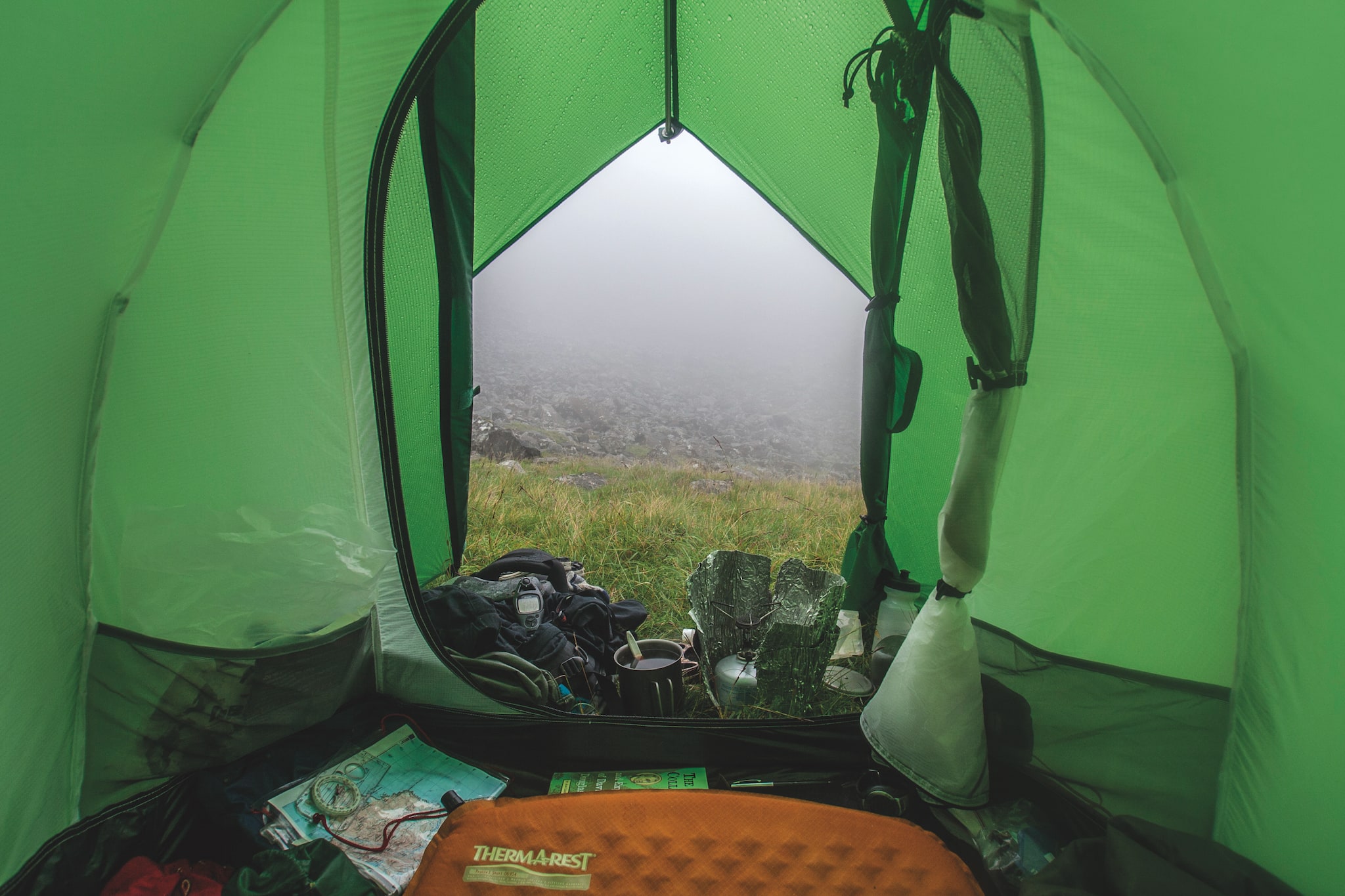
Wet gear and stove in the porch, door open for ventilation; only keep dry gear in the inner tent!
© Chris Townsend
Feet
If your feet are wet from the day’s walk, dry them thoroughly with a towel. Avoid getting into your sleeping bag with wet feet.
Keeping warm
Change into clean and dry sleeping clothes – don’t wear damp or sweaty hill clothes in your sleeping bag. Don’t start off by wearing all your layers. Nights usually get colder towards dawn. Keep a layer or two in easy reach.
High winds, or changing wind direction
If winds strengthen or change direction, you may need to adjust your pitch. Monitor the situation: some flapping and flexing is fine, but be ready to tighten guys, hammer in extra pegs, or even re-pitch the shelter if it gets bad enough.
Condensation
The old advice of ‘don’t touch the wet walls of your tent’ still applies – condensation can brush off on your clothing or sleeping bag, and even water-resistant down can lose some efficiency if exposed to moisture over several days. If condensation gets heavy in the early hours, mop it up with your towel before it drips on you.
Sagging flysheet
Some tent fabrics sag when damp, especially silnylon. This can result in flapping if it’s windy. In stormy conditions you may need to tighten guys to take in any sag. Some shelters supported by trekking poles can be adjusted from inside by lengthening the pole.
Snow build-up
If it snows overnight, you may need to periodically tap the flysheet to prevent it from overloading your shelter. Steep-walled shelters perform better in heavy snow.
What to do if you get cold
You’re well fed, wearing dry clothes, and still you wake up cold at 3am. What next?
- Make sure your sleeping bag or quilt is zipped up and secure, including baffles.
- Keep head and feet warm. Put on a woolly hat and thick, dry socks.
- If you can feel cold seeping through your sleeping mat, put spare clothing or even your pack underneath you.
- If you have a down or insulated jacket, consider laying it on top of your sleeping bag. This can be more effective than wearing it.
Bivvy bags
Bivouac aficionado Ronald Turnbull covers his thoughts on bivvying.
A comfy bivvy is like a short long-distance walk, or non-intoxicating beer. Comfort isn’t what it’s about. It’s about having your head out in the wind and your nose pointing straight at the stars. And if you wanted to be asleep and snoring as the red deer passes in the night, as the slow brown sunrise creeps between two tufts of heather – then you need to be somewhere that isn’t a bivvy. Like a hostel, or a bothy, or safe at home in bed.
Okay, so you’ll enjoy the experience even more if you’re not completely cold and miserable. With that in mind, I always allow 15 minutes at the end of the day to look around for the perfect spot to unroll the bag. There are four factors that matter. Firstly, what can you see? In high summer, sunrise is in the north-east. Even better if there’s a lake or ocean for that sunrise to reflect in.
Second is shelter. Which way is the wind, what is it forecast to do overnight, and what if it doesn’t do that but something different? The ideal is a light movement of air, to carry away moisture and let the breathable membrane do its job. A breeze may also be needed to keep away the midges. But not strong enough to flap the bag in a noisy way, or to press it against your body, which is a way of losing warmth.
What if that wind does shift round, bringing in some rain or sleet? It’s a straightforward matter to shift your bivvy bag to a sheltered little hole somewhere nearby. Well it is if you worked out, before it got dark, where that sheltered little hole was going to be.
Thirdly: what are you sleeping on? No sleeping mat, whether inflatable or foamy, can match a springy bed of heather or a mattress of last summer’s deer grasses. If it fails to squeeze out water when you stand on it, so much the better.
And factor four is the same as factor one. No heathery bed, however dry or sheltered, is any good unless you can see the sunrise…
Hammocks
Although a hammock is rarely an option in the British hills, if the pitch is appropriate there’s nothing more comfortable.
Many backpacking hammocks can now be found that weigh well under a kilo. Look for a sheltered, wooded spot, but be careful to avoid trees with dead branches that could fall in high winds.
A less-obvious benefit is that it doesn’t matter what the ground is like, because you won’t be sleeping on it! You will need the hammock itself and a protective tarp; in most conditions you’ll also need an underquilt, as the hammock compresses the insulation you’re lying on.
Header image © Chris Townsend

